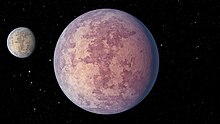HD 260655
| Observation data Epoch J2000 Equinox J2000 | |
|---|---|
| Constellation | Gemini |
| Right ascension | 06h 37m 10.79880s[1] |
| Declination | +17° 33′ 53.3332″[1] |
| Apparent magnitude (V) | 9.77±0.11[2] |
| Characteristics | |
| Evolutionary stage | Main sequence |
| Spectral type | M0.0V[2] |
| Apparent magnitude (B) | 11.10±0.07[2] |
| Apparent magnitude (V) | 9.77±0.11[2] |
| Apparent magnitude (G) | 8.878±0.003[2] |
| Apparent magnitude (J) | 6.674±0.024[2] |
| Apparent magnitude (H) | 6.031±0.016[2] |
| Apparent magnitude (K) | 5.862±0.024[2] |
| Astrometry | |
| Radial velocity (Rv) | −58.64±0.16[1] km/s |
| Proper motion (μ) | RA: −764.414 mas/yr[1] Dec.: 337.883 mas/yr[1] |
| Parallax (π) | 100.0232 ± 0.0208 mas[1] |
| Distance | 32.608 ± 0.007 ly (9.998 ± 0.002 pc) |
| Details[2] | |
| Mass | 0.439±0.011 M☉ |
| Radius | 0.439±0.003 R☉ |
| Luminosity (bolometric) | 0.03631±0.00018 L☉ |
| Surface gravity (log g) | 5.20±0.07 cgs |
| Temperature | 3803±10 K |
| Metallicity [Fe/H] | −0.43±0.04 dex |
| Rotation | 37.5±0.4 d |
| Rotational velocity (v sin i) | <2.0 km/s |
| Age | 2-8 Gyr |
| Other designations | |
BD+17 1320, GJ 239, HD 260655, HIP 31635, CCDM J06372+1734A, WDS J06372+1733A, Ci 20 393, G 110-5, G 109-14, G 105-49, LFT 477, LHS 1858, LSPM J0637+1733, LTT 11880, NLTT 16743, PLX 1538, PM J06371+1733, Wolf 287, TOI-4599, TIC 307809773, TYC 1333-1683-1, GCRV 4273, IRAS 06342+1736, 2MASS J06371092+1733526[3][2] | |
| Database references | |
| SIMBAD | data |
HD 260655 (also known as GJ 239 or TOI-4599)[2] is a relatively bright and cool M0 V red dwarf star located 33 light-years (10 parsecs) away from the Solar System in the constellation of Gemini. HD 260655 has two confirmed rocky planets, named HD 260655 b[4][5] and HD 260655 c, that were discovered in 2022. Both planets were detected by the TESS mission and confirmed independently with archival and new precise radial velocity data obtained with the HIRES observatory since 1998, and the CARMENES survey instruments since 2016.[2]
Star
[edit]The star is among the earliest-type M dwarfs in the night sky. Its mass is 0.439 times that of the Sun, and its radius is also 0.439 times that of the Sun. It has a temperature of 3,803 K (3,530 °C; 6,386 °F) and a rotation period of 37.5 days.[2] Other designations of HD 260655 include Wolf 287, GJ 239, TOI-4599, HIP 31635 and LHS 1858.[3]
Planetary system
[edit]
The mass of planet b is 2.14 ME, with a radius of 1.240 R🜨, and planet c has a mass of 3.09 ME, with a radius of 1.533 R🜨, making both planets super-Earths.[2] The equilibrium temperature of HD 260655 b is 709 K (436 °C; 817 °F), while HD 260655 c sits at a temperature of 557 K (284 °C; 543 °F).[2][6] The orbital period of HD 260655 b is 2.77 days, while HD 260655 c has an orbital period of 5.71 days.[2]
Both planets are ideal candidates for future study of exoplanet atmospheres due to their closeness and their bright red dwarf star. However, as of 2022, there is no evidence that HD 260655 b or HD 260655 c have atmospheres.[7] HD 260655 is also the fourth-closest known system with multiple transiting exoplanets, after HD 219134, LTT 1445, and AU Microscopii.[8]
| Companion (in order from star) |
Mass | Semimajor axis (AU) |
Orbital period (days) |
Eccentricity | Inclination | Radius |
|---|---|---|---|---|---|---|
| b | 2.14±0.34 M🜨 | 0.02933±0.00024 | 2.76953±0.00003 | 0.039+0.043 −0.023 |
87.35±0.14° | 1.240±0.023 R🜨 |
| c | 3.09±0.48 M🜨 | 0.04749±0.00039 | 5.70588±0.00007 | 0.038+0.036 −0.022 |
87.79±0.08° | 1.533+0.051 −0.046 R🜨 |
References
[edit]- ^ a b c d e Vallenari, A.; et al. (Gaia collaboration) (2023). "Gaia Data Release 3. Summary of the content and survey properties". Astronomy and Astrophysics. 674: A1. arXiv:2208.00211. Bibcode:2023A&A...674A...1G. doi:10.1051/0004-6361/202243940. S2CID 244398875. Gaia DR3 record for this source at VizieR.
- ^ a b c d e f g h i j k l m n o p q Luque, R.; Fulton, B. J.; Kunimoto, M.; Amado, P. J.; Gorrini, P.; Dreizler, S.; Hellier, C.; Henry, G. W.; Molaverdikhani, K.; Morello, G.; Peña-Moñino, L. (2022-04-21). "The HD 260655 system: Two rocky worlds transiting a bright M dwarf at 10 pc". Astronomy & Astrophysics. 664: A199. arXiv:2204.10261. Bibcode:2022A&A...664A.199L. doi:10.1051/0004-6361/202243834. S2CID 248300168.
- ^ a b "HD 260655". SIMBAD. Centre de données astronomiques de Strasbourg. Retrieved 2022-07-31.
- ^ "The Extrasolar Planet Encyclopaedia — HD 260655 c". Extrasolar Planets Encyclopaedia. Retrieved 2022-07-01.
- ^ Carter, Jamie. "Found: Two New Rocky, Earth-Sized Planets In Our Cosmic Backyard—And There Could Be More". Forbes. Retrieved 2022-07-01.
- ^ a b Brennan, Pat. "Discovery Alert: Two New, Rocky Planets in the Solar Neighborhood". Exoplanet Exploration: Planets Beyond our Solar System. Retrieved 2022-07-01.
- ^ "Two rocky super-Earths discovered just 33 light-years away". Digital Trends. 2022-06-19. Retrieved 2022-07-01.
- ^ "Two Rocky Exoplanets Found Orbiting Bright Red Dwarf | Sci-News.com". Breaking Science News | Sci-News.com. 10 May 2022. Retrieved 2022-07-01.
